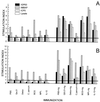Subunit vaccination of mice against new world cutaneous leishmaniasis: comparison of three proteins expressed in amastigotes and six adjuvants
- PMID: 10678945
- PMCID: PMC97286
- DOI: 10.1128/IAI.68.3.1328-1336.2000
Subunit vaccination of mice against new world cutaneous leishmaniasis: comparison of three proteins expressed in amastigotes and six adjuvants
Abstract
A mixture of well-defined recombinant antigens together with an adjuvant that preferentially stimulates specific gamma interferon (IFN-gamma)-secreting helper type 1 CD4(+) T cells (Th1 cells) presents a rational option for a vaccine against leishmaniasis. The potential of this approach was investigated in murine infections with Leishmania mexicana, which are characterized by the absence of a parasite-specific Th1 response and uncontrolled parasite proliferation. A mixture of three antigens (glycoprotein 63, cysteine proteinases, and a membrane-bound acid phosphatase), which are all expressed in amastigotes, the mammalian stage of the parasite, were used for the immunization of C57BL/6 mice in combination with six adjuvants (interleukin 12 [IL-12], Detox, 4'-monophosphoryl lipid A, QS-21, Mycobacterium bovis BCG, and Corynebacterium parvum). All six vaccine formulations containing the mixture of recombinant antigens were protective against challenge infections with promastigotes, the insect stage of the parasite, in that mice controlled and healed infections but developed transient and, in certain cases, accentuated disease. The most effective adjuvants were IL-12 followed by Detox. Further studies using these two adjuvants showed that a similar protective effect was observed with a mixture of the corresponding native proteins, and mice which had controlled the infection showed a preponderance of IFN-gamma-secreting CD4(+) T cells in the lymph nodes draining the lesion. Using the recombinant proteins individually, it is shown that the relatively abundant cysteine proteinases and glycoprotein 63, but not the acid phosphatase, are able to elicit a protective response. The results are discussed in comparison to previous studies with subunit vaccines and with respect to cell biological aspects of antigen presentation in Leishmania-infected macrophages.
Figures






References
-
- Aebischer T. Recurrent cutaneous leishmaniasis: a role for persistent parasites? Parasitol Today. 1994;10:25–28. - PubMed
-
- Aebischer T, Morris L, Handman E. Intravenous injection of irradiated Leishmania major into susceptible BALB/c mice: immunization or protective tolerance. Internat Immunol. 1994;6:1535–1543. - PubMed
-
- Afonso L C C, Scharton T M, Vieira L Q, Wysocka M, Trinchieri G, Scott P. The adjuvant effect of interleukin-12 in a vaccine against Leishmania major. Science. 1994;263:235–237. - PubMed
-
- Alexander J. A radioattenuated Leishmania major vaccine markedly increases the resistance of CBA mice to subsequent infection with Leishmania mexicana mexicana. Trans R Soc Trop Med Hyg. 1982;76:646–649. - PubMed
Publication types
MeSH terms
Substances
LinkOut - more resources
Full Text Sources
Other Literature Sources
Research Materials

